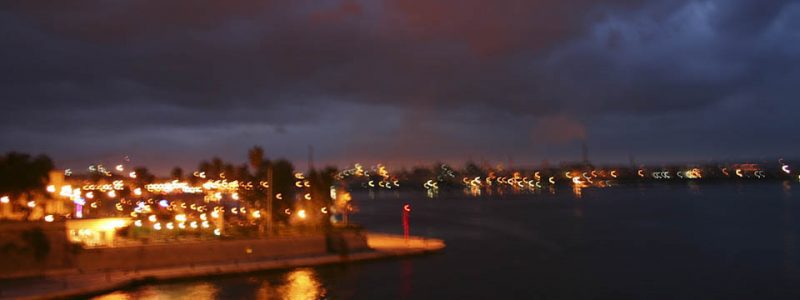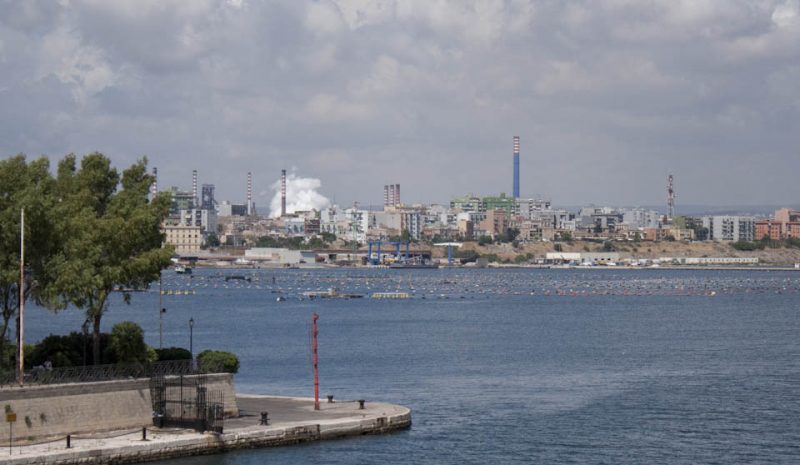Taranto and the pink candyfloss skies
Taranto used to regard the pink candyfloss skies as a local attraction. Now they are an emblem of an incredible environmental disaster.
Taranto by the Ionian Sea is a beautiful city which should be known for its mussels, its palio and its mysterious Easter processions. But in the book ‘101 cose da fare in Puglia almeno una volta nella vita’, the writer Rossano Astremo suggests an alternative attraction. He wants you to notice the red skies over the city.
The red sky phenomenon has been visible since the 1960s. At that time people saw it as a miracle caused by unique meteorological conditions, but now every child knows the pink skies are a poisonous by-product of Europe’s biggest steelworks, Ilva.

At night red dust can be seen in the sky over Mare Piccolo
The pollution sends a carpet of black soot and red ‘polvere’ or powder down over large parts of Taranto and especially the Tamburi area, where a new law forbids residents from touching the soil. In addition, Ilva has been accused of emitting carcinogenic dioxins amounting to 8.8% of the total dioxins emissions in Europe and causing cancer death rates at 15% above the national average.
The furnaces are still burning
On this background it was not surprising that a magistrate in August 2012 ordered a shutdown of the most polluting furnaces and placed the owners of the steelworks under house arrest. But events took and unexpected turn when unions went on strike to protest against the magistrate’s decision. They were backed by the Italian president, the government, and the ministers of the environment and health, who claimed that losing jobs also makes people ill.
So the furnaces at Ilva are still burning, while grazing has been banned within 20 km of Ilva and almost 3,000 livestock with excessive dioxin levels have been slaughtered. Mussel are still cultivated in Mare Piccolo but the beds have been moved away from the steelworks. And the residents in Tamburi will have to keep sweeping their balconies twice a day, while heavy investments are being made to transform the steelworks to a cleaner technology and save thousands of jobs in Taranto and other parts of Italy.
Leave a Reply
Want to join the discussion?Feel free to contribute!
Leave a Reply Cancel reply
This site uses Akismet to reduce spam. Learn how your comment data is processed.




Scary that cancer levels are so high, yikes! Glad to hear that they’re making improvements though.
It’s definitely about time something is done.
This is a national tragedy.
And the fact that it had to be a magistrate to take action after decades that nobody seemed to care, is a tragedy in the tragedy.
There is an almost identical steelwork in Korea: it’s buried under a dome in order to avoid chemicals to escape into the atmosphere.
You’re absolutely right. It is a double tragedy and it’s still running. The Korea solution, however, sounds pretty radical. Wonder how the workers are doing under that dome.
What a horrible double-edged sword: increased risk of cancer vs. job-loss. Don’t people move away from the area?
I don’t think they have that many places to go to.
Oh my, that is insane. Absolutely insane. How long will it be until the changeover to cleaner technology is complete? I assume it will be years, and what a terrible toll in illness and early death. How sad.
It is sad. And last week the steel work was hit by a cyclone, while the management and the local authorities closed down production, and the workers – who are risking their health – demonstrated to keep their jobs. It just goes on and on.
It is so sad when there seems to be no way out. And what a shame to wait until everything is on red alert to begin to make necessary changes. I guess it is human nature, but… Great article.
Thank you for the feedback and I agree, it is a sad, sad story that has hit the people in Taranto very hard.
Not good when a city relies so heavily on one major industry. What about tourism being discouraged?
There are jobs at stake there too. Lesson here: A failure of leadership.
I suppose you’re right. Local government in Taranto has been a farce for years, and it will take years before the city begins to attract the number of tourists it’s natural and cultural heritage deserves.